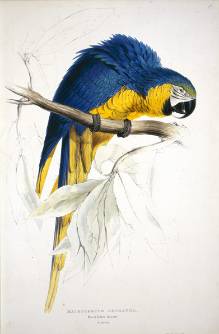'Illustrations of the family of Psittacidae, or parrots : the greater part of them species hitherto unfigured' by Edward Lear.
One of the most requested must see books in the Rothschild Library is a work without text produced by a short-sighted, socially inept, depressive artist with failing health. Someone we may know better as an author of nonsense poetry and a caricaturist.
This month sees the bicentenary of the birth of Edward Lear so it seems appropriate to highlight his major work of natural history, the ‘Illustrations of the family Psittacidae or parrots’.
Lear was born 12th May 1812, the 20th child of 21 children, born to a prosperous family in London. It appears that there was some sort of hiatus and the family became divided, although no details remain due to Lear destroying diaries from his youth and spreading stories of bankruptcy that cannot be substantiated!
Blue and yellow Macaw
Image reference: 008408
However, the young Edward Lear was cared for by his sister Ann, 22 years his senior, during his childhood and teenage years. He spent only one year at school, and either taught himself or was taught by his sisters Ann and Sarah. Both women were gifted artists so he learned to draw using objects from nature for his artwork.
From approximately 1828 he began to work as a zoological draughtsman, quite often on projects associated with the new zoological gardens in London. In 1830 he conceived his plan to produce a great work of zoological illustration and applied to the zoo for permission to draw the parrots. Permission was granted and Lear used to work in the aviaries with the keeper, Gosse, holding the parrots while Lear measured and drew his subjects.
He made many pencil sketches and notes on colours, drawing the parrots in many positions. Visitors began to notice him working and he was constantly irritated by them, occasionally drawing a caricature of the most annoying. The intention of the work was to draw the entire family of psittacidae which meant having to use parrots in private collections, such as those of Lord Stanley of Knowsley hall, and if all else failed using stuffed specimens supplied by John Gould (1804-1881), who worked at the Zoological Gardens as a taxidermist.
The first part of the work appeared in 1830 and was remarkeble for several reasons:
- Large folio size - which became the norm afterwards
- Working from living birds - stuffed specimens were the usual subjects
- Lear produced his own lithographs - he worked closely with Hullmandell, one of the lithographic pioneers
- The work was devoted to one Family of birds - rather than the wide ranging works of earlier authors
The intention was to produce 14 parts but eventually 42 plates were produced in 12 parts. The whole family of psittacidae was not figured as the book was not a financial success even though it had some eminent subscribers.
Subscribers page
The book was an artistic and natural history success. The day after publication of the first part, Lear was proposed as an Associate of the Linnean Society, he was just eighteen years old. One of his supporters was Thomas Bell (1792-1880) for whom he worked on the 'Monograph of the Testudinata' and 'A history of British Quadrupeds, including Cetacea'.
He also worked for John Gould, the producer of many folio works on birds. Gould was an unscrupulous and ambitious businessman who used Lear to produce some fine plates but often did not acknowledge him as the artist. Their best known collaboration being the 'Birds of Europe' for which Lear produced plates of the large and eccentric birds, probably best known for the owls.
Aegolius funereus, Tengmalm's owl
Image reference: 028000
Lear spent the happiest five years of his life at Knowsley Hall where he was working for Lord Stanley, 13th Earl of Derby (1775-1851). Stanley was undertaking academic study of natural history and had amassed the largest private menagerie in the country. He employed Lear to draw the animals for identification and classification purposes. Lear lived at Knowsley Hall and in the evening entertained the children with drawings and stories. He was accepted in to family life and made many friends.
In 1837 Lear went to Rome. His failing health and eyesight and tours to the Lake District and Ireland influenced his desire to take up landscape painting. He was an intrpid traveller and wrote journals about his travels to such places as Greece, Albania, Italy and Corsica. He lived near Rome for most of the rest of his life, and when he finally became too ill to work, he sank into depression, a feature of his earlier life. He died on 19th January 1888 in Sanremo, Liguria, Italy.
As this is Lear's bicentenary there are many events taking place, for more information please see http://nonsenselit.wordpress.com/. Also you will find some of his works digitised on the Biodiversity Heritage Library
Written by Alison Harding, Librarian (Tring)
For more information about the Library & Archives please visit visit our http://www.nhm.ac.uk/library



